POTHOS GROWING TIPS
Temperature and humidity:
Plants should be kept at temperatures above 50 degrees F, with ideal temperature range between 60-80 degrees F. Pothos prefers high humidity similar to its native habitat, but is tolerant of average or dry air. Plants will benefit from supplemental air moisture such as misting or a room humidifier during winter when indoor air is drier.
Soil type:
Grow in a high quality, well-draining potting mix. Pothos prefers a slightly acidic pH of 6.1 to 6.5, but is tolerant of values slightly above or below.
Propagation:
Pothos is easily propagated through stem cuttings. Cut stems 6 inches long just below a leaf node and place in water. Roots will develop over a month or two. Change water every 2-3 weeks. Plant well-rooted cuttings in fresh potting soil. Grow multiple stems in the same pot for the lushest growth.
Plants can also be propagated through division. Gently cut the root ball into sections and repot in fresh soil, leaving 1-2 inches of space around the root ball.
What Type of Container and Soil Should You Use For a Pothos Plant?
Pothos plants aren’t fussy so you can use any container you want as long as it has a drainage hole at the bottom where excess water can flow through.
Good drainage via drainage holes is crucial to the health of your plant because it helps prevent root rot and common problems like fungus gnats.
If you purchased a potted pothos plant that has already begun to vine, don’t worry about repotting unless it’s root bound.

Close-up shot of pothos plant with shades of green and cream, sitting on a brown background.
Pothos plants don’t need to be repotted in fresh soil unless the roots have grown so large that they’re preventing water from pouring out through the drainage hole.
Pothos plants actually thrive in smaller containers and can grow several feet of vine without being transferred to a larger pot.
Smaller pots will also help contain the plant so it doesn’t grow overabundantly.
If your pothos came in a plastic container, that’s perfectly fine, just be aware that plastic containers retain more water than clay or terracotta pots, so you’ll have to be careful not to overwater, especially in the winter months.
As far as soil, the best soil for pothos plants is one that is well-draining. A good potting mix for indoor plants will do.
Similar to succulents, pothos plants don’t do well when they sit in soggy soil for days at a time which is why soil is so important.
Описание эпипремнума золотистого
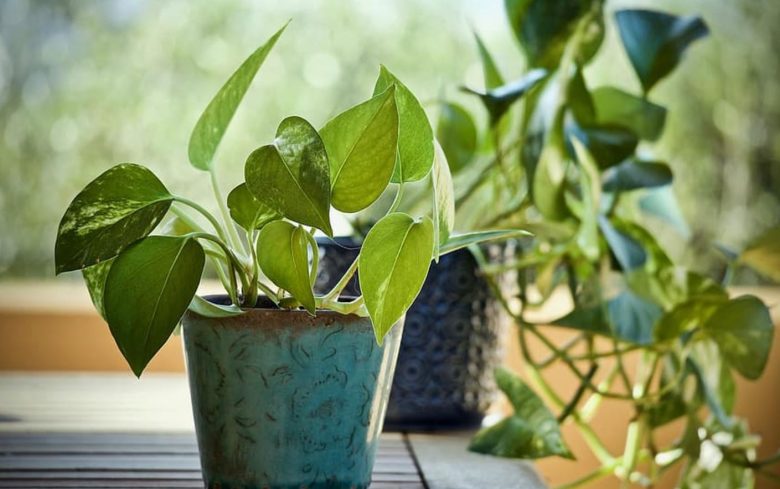 L ‘Эпипремнум золотистый, то есть типичный вид потоса, представляет собой вечнозеленое растение, похожее на небольшой кустик стеблей лианозиса. В природе эти лианы растут, используя более крупные растения в качестве кольев, как и они. монстера И, антуриум. В квартирном выращивании эту особенность, присущую всем потосам, можно использовать в декоративных целях для выращивания растений в ниспадающей форме (на подвесных горшках или на полках книжных шкафов) или в колонновидной (с помощью опекунов).
L ‘Эпипремнум золотистый, то есть типичный вид потоса, представляет собой вечнозеленое растение, похожее на небольшой кустик стеблей лианозиса. В природе эти лианы растут, используя более крупные растения в качестве кольев, как и они. монстера И, антуриум. В квартирном выращивании эту особенность, присущую всем потосам, можно использовать в декоративных целях для выращивания растений в ниспадающей форме (на подвесных горшках или на полках книжных шкафов) или в колонновидной (с помощью опекунов).
Стебли
С годами стебли сильно разрастаются, достигая более 1.5 м в длину. В природе они легко превышают 10 м и растение ведет себя как сорняк. Цвет у них пестрый, с желтой мраморностью на зеленом основании.Куст, как и стебли, также сильно раскидистый и может достигать значительных размеров.
Листья
Листья потоса, обычно сердцевидной формы, среднего или маленького размера, прикрепляются к стеблям. Когда растение молодое, оно имеет глянцевые темно-зеленые листья, но пестрые с большими и неброскими золотисто-желтыми пятнами. Однако по мере взросления растения количество желтых пятен на листьях увеличивается, пока у полностью зрелого потоса листья не станут в основном желтоватыми.Форма, размер и окраска листьев отличают разные виды.
How to Grow Pothos
Although you can grow pothos outside, unless you live in USDA Growing Zone 10 or above, it’s a good idea to keep them on a covered patio or balcony in movable pots. That way, you can rescue them if bad weather hits.
The ideal temperatures are 60ºF or above, so if your area never gets colder than that, feel free to plant them in the garden. Any lower temperature will either kill your pothos or make it struggle.
Indoors
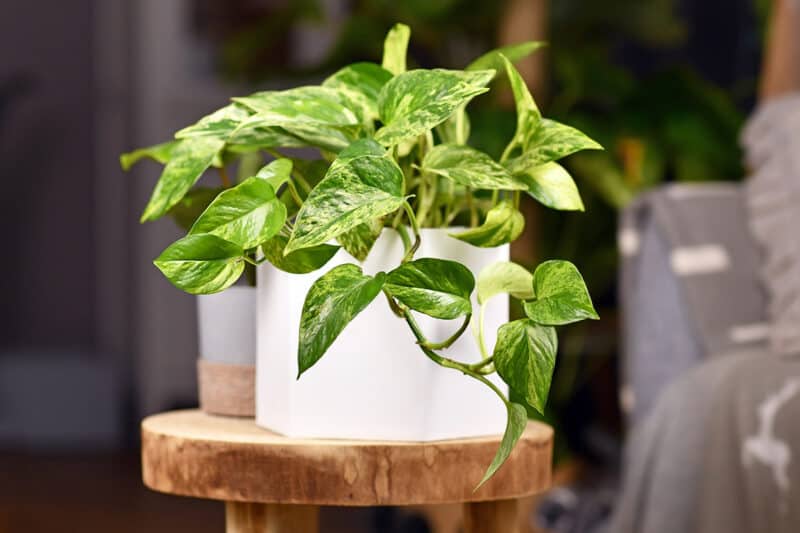
Indoors, pothos are perfectly happy in the same temperatures that you prefer – anything from 60°F and up.
Use a good quality potting mix that drains well. Pothos doesn’t like wet feet. These houseplants can be grown in standard containers or hanging baskets. Whichever you choose, be careful not to overwater and empty any catchment container an hour after watering.
Most varieties are long vines that can trail along shelves, mantels, or cupboards. You can also put a moss pole in a container to give them something to climb up.
Feed once every six months with a slow-release container fertilizer made for foliage plants. Only water when the top inch of potting mix becomes dry. The soil should be moist, but don’t soak the soil so that it’s pooling.
Remove any stems or leaves that are damaged, diseased, or turn yellow. This normally happens because the pothos has been hit by a child or pet, or the leaves are damaged by direct sunlight.
In Water
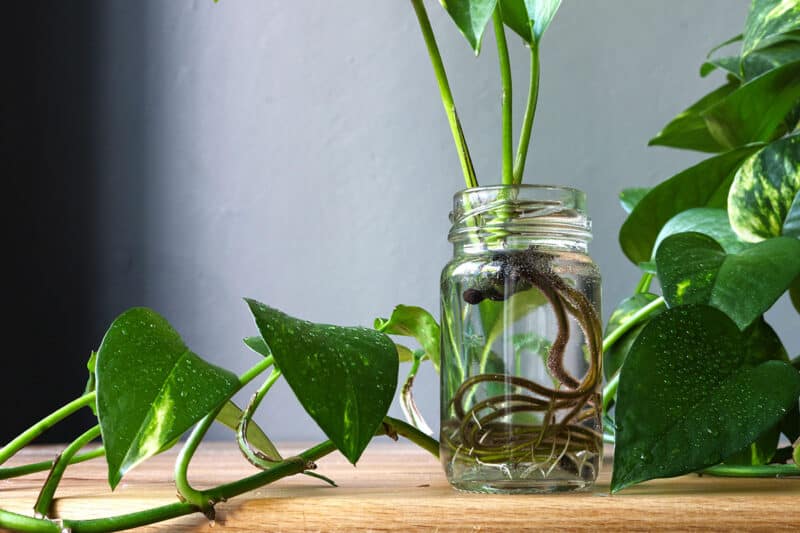
You can grow pothos in water – yes you read that right. If you choose a clear container, you can even watch the roots develop.
To get started, cut a length of healthy pothos vine. Make sure there are at least four or five leaf nodes on your cut piece.
Fill a clear vase or glass container with water. Preferably use water that’s not chlorinated, but if yours is, simply add the water a day or two before you put your plant in.
Place a couple of drops of liquid plant fertilizer in the water. Follow the instructions of your particular brand.
Remove the leaves of the vine that will be submerged as they will rot and contaminate the container.
Lower the vine into the water with the upper part draped over the edge of the container to keep it afloat.
Replace the water every two weeks or if it looks a little dirty. Add a couple of drops of liquid fertilizer each time and place the plant in indirect sunlight as direct is too hard on the leaves.
Keep the roots submerged and make sure to clean the vase each time you replace the water. You can lift the whole plant out to do this, so just be careful of the roots each time.
If your plant was originally growing in soil, it might need a few weeks to adjust to the aquatic life.
Outside
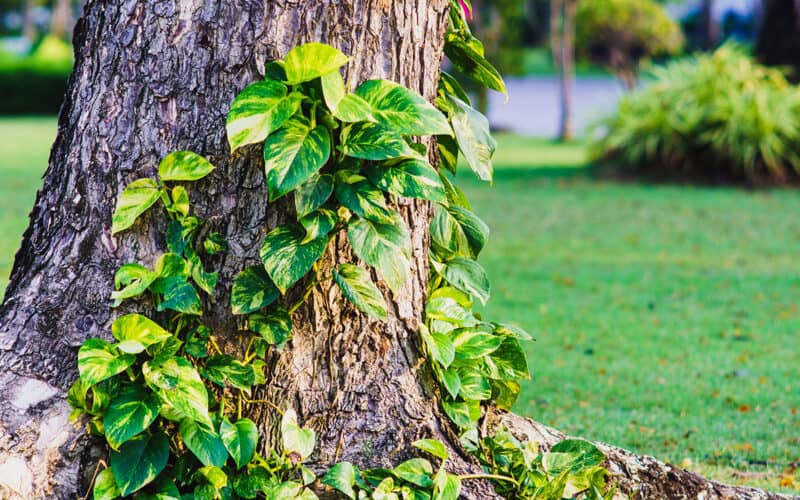
In its natural environment, pothos grows under the canopy of trees in humid forest environments, so try to recreate that. Plant in indirect sunlight at the base of a tree for the plant to trail up. You could also set up a trellis under a patio cover.
Pothos can reach up to 40 feet in length, so be prepared for that. I planted one outside and it grew out-of-control and nearly took over the canopy of the tree. I ended up having to remove it.
Aim for a soil pH of 6.1 to 6.5, but they are unfussy really unless the soil is too acidic – under 5.8 pH. Make sure the soil remains moist, but not soaking.
Remember that if your temperatures drop below 60ºF at any time, you should plant pothos in containers and move them to a warm location inside. Otherwise, provide them protection if you just have a night or two of unusually cold weather.
Although not a huge feeder, pothos can be fed with a balanced fertilizer every three weeks in spring and summer if it’s outside. Stop in winter to let it rest.
The most beautiful Scindapsus pictus varieties
There are several varieties of satin pothos that differ predominantly in their leaf pattern. In some cases, a Scindapsus pictus variety may seem almost completely silver, and barely green at all.
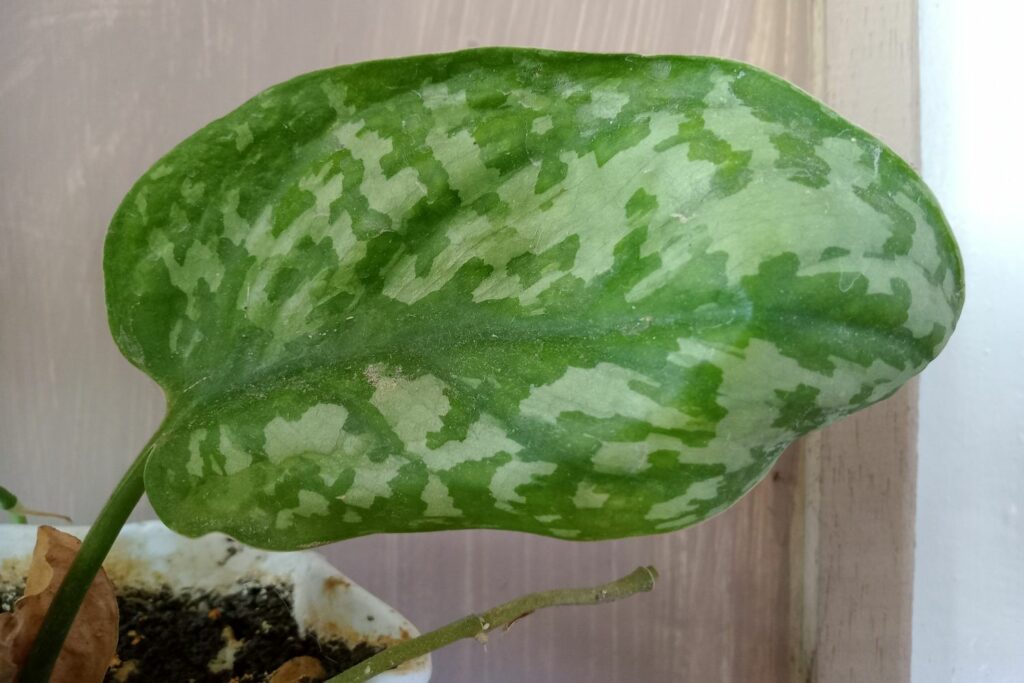 Some varieties of Scindapsus pictus, such as ‘Argyraeus’, only have small dots on their leaves [Photo: DIAN KAILIWATI/ Shutterstock.com]
Some varieties of Scindapsus pictus, such as ‘Argyraeus’, only have small dots on their leaves [Photo: DIAN KAILIWATI/ Shutterstock.com]
- Scindapsus pictus ‘Argyraeus’: Scindapsus variety with somewhat smaller leaves with rather small, silvery spots.
- Scindapsus pictus ‘Exotica’: This variety appears almost completely silver due to the large patterning.
- Scindapsus pictus ‘Trebie’: The leaves of this variety have large, silvery spots and a green central stripe.
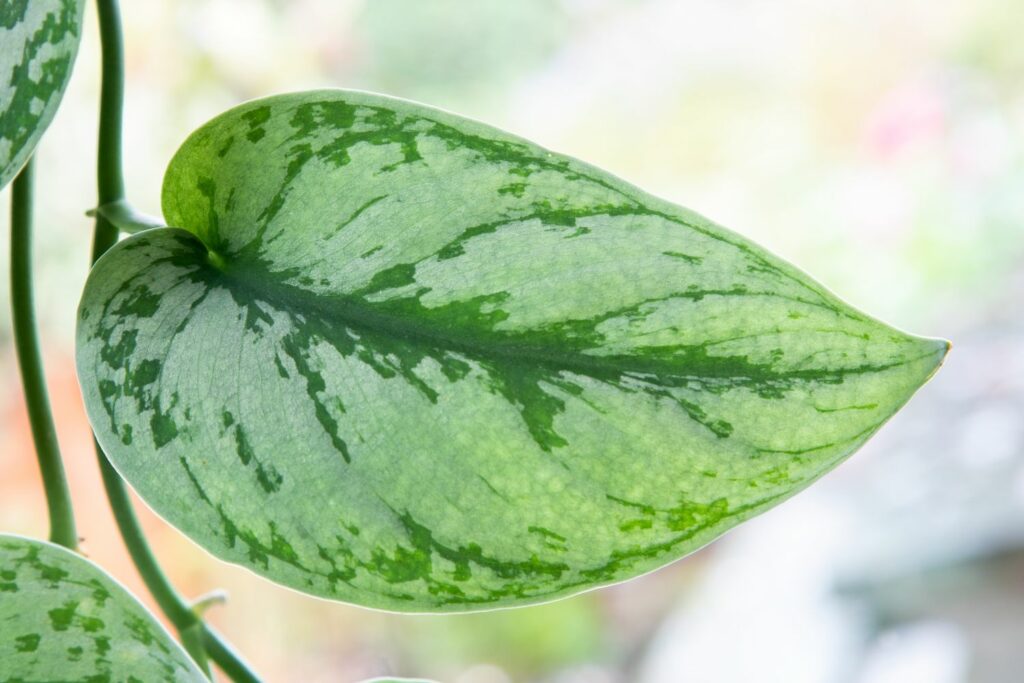 The leaves of Scindapsus pictus ‘Trebie’ have large, silver patches [Photo: Danny Hummel/ Shutterstock.com]
The leaves of Scindapsus pictus ‘Trebie’ have large, silver patches [Photo: Danny Hummel/ Shutterstock.com]
- Scindapsus pictus ‘Silvery Ann‘: Irregular, large silver spots.
- Scindapsus pictus ‘Silver Splash’: Exhibits delicate, light green spots on the leaves.
Beautiful and Useful Pothos Varieties
If you thought that pothos only had “one face and one look” now you know otherwise.
As you can see the different types and varieties of this houseplant are suitable to different places. Not every pothos needs to go on top of that very tall cupboard!
But there is more. I would like to leave you with a fact. Pothos are excellent air cleaners!
They can purify common toxins from the air of your room, especially those that many types of paint and furniture finish give off, like VOC benzene.
So, you get two benefits form this plant: a beautiful room and a healthy room… and for no hassle at all!
Written By
Adriano Bulla
After many years as an academic in London, Adriano Bulla became a writer, publishing books like A History of Gardening, Organic Gardening and Elements of Garden Design; he then decided to become a gardener, following his childhood dream, and has been following his dream writing and gardening professionally in Southern Europe, where he has specialized in new and innovative organic gardening fields and techniques, like permaculture, regenerative agriculture, food forests and hydroponics.
Сциндапсус пиктус или Сциндапсус расписной (Scindapsus pictus)
Очень популярный и широко распространённый вид.
Взрослый лист матовый тёмно-зелёного цвета с тонкой белой окантовкой. По всей поверхности листа разбросаны серебристо-белые пятна различного размера. Характерной особенностью вида является асимметрия листьев относительно центральной жилки.
При хороших условиях и высокой влажности листья сциндапсуса расписного могут вырастать до 15 см.
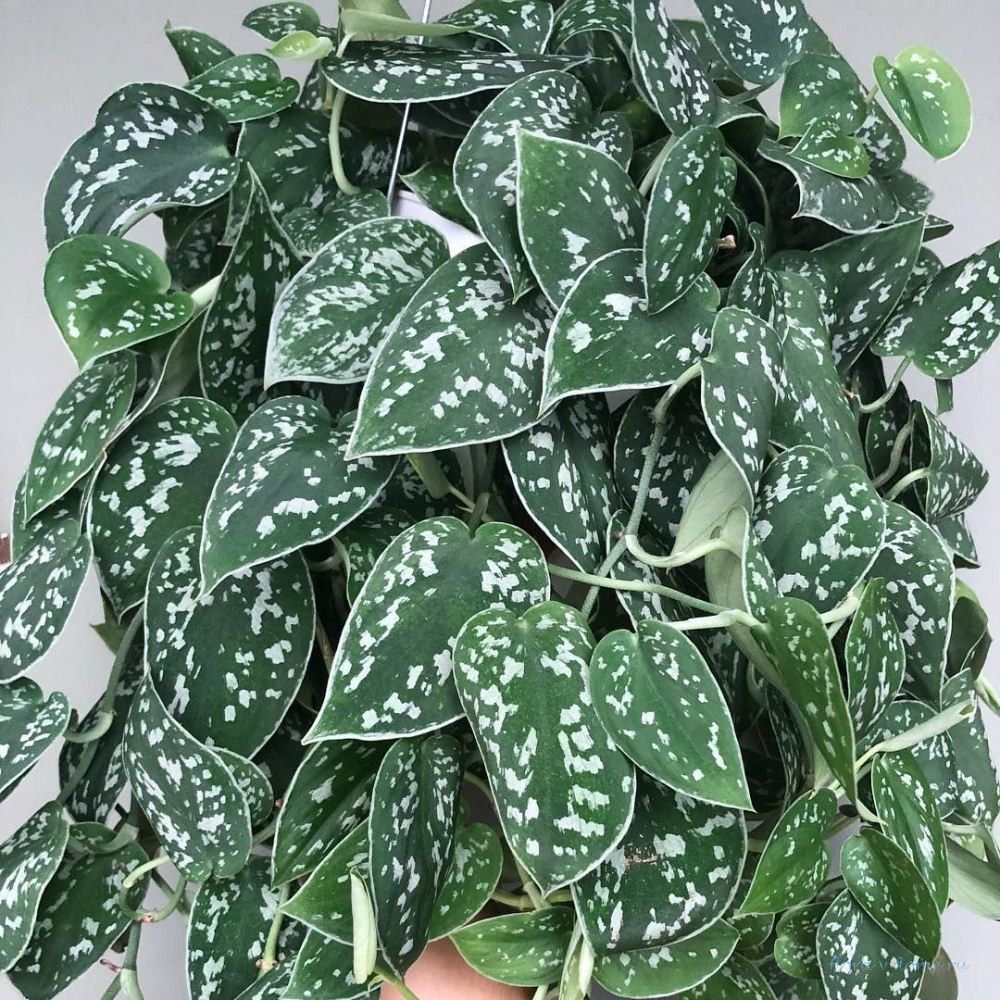 Сциндапсус расписной (Scindapsus pictus)
Сциндапсус расписной (Scindapsus pictus)
Сорта сциндапсуса пиктус (расписного):
Сциндапсус Аргиреус (Scindapsus Argyraeus)
Популярный сорт сциндапсуса расписного. Широкие небольшие листья с мелкими белыми пятнами.
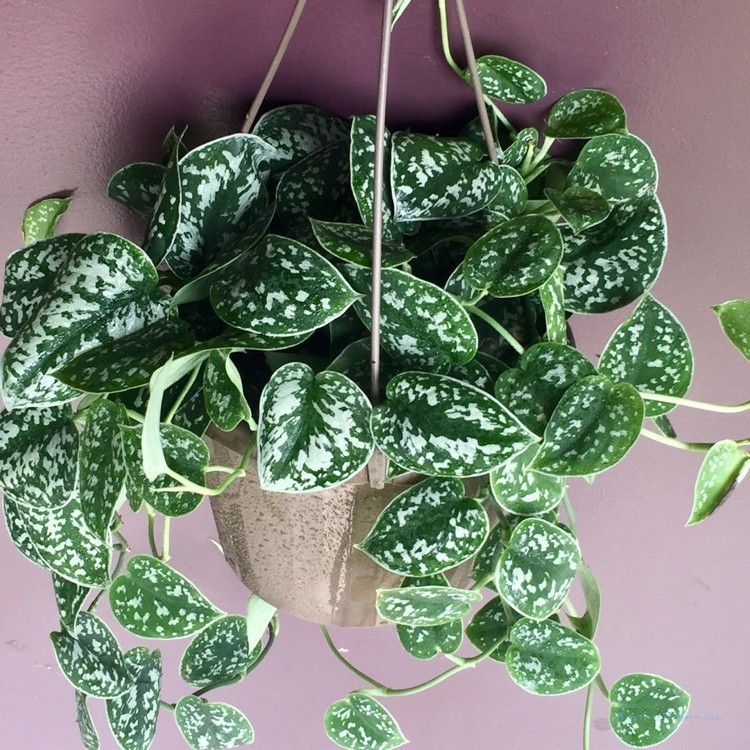 Сциндапсус pictus Argyraeus
Сциндапсус pictus Argyraeus
Сциндапсус Пиктус Треби (Scindapsus Pictus Trebie)
Распространённый сорт – крупные асимметричные листья со светлым контрастным рисунком – пятна, штрихи, полосы. Лист слегка рельефный, поверхность листа бархатистая. Неприхотлив, теневынослив, но яркость рисунка зависит от интенсивности и продолжительности освещения.
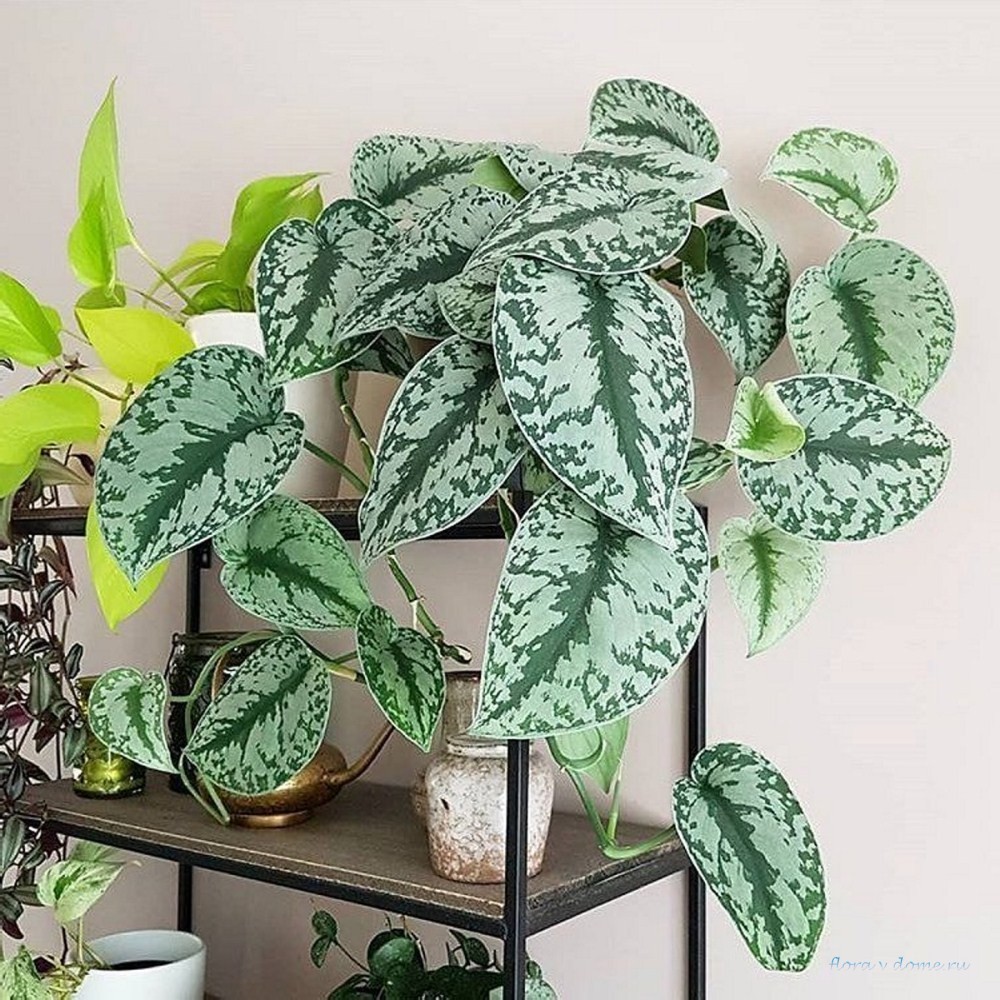 Сциндапсус пиктус Треби (Scindapsus pictus Treble)
Сциндапсус пиктус Треби (Scindapsus pictus Treble)
Сциндапсус Сильвер Энн (Scindapsus Pictus Silvery Ann) или Сатин Потос (Satin Pothos)
Серебристые пятна почти полностью покрывают матово-зелёную поверхность листа. Из всех сортов сциндапсуса расписного, у сильвер энн – самое обширное покрытие пятнами основного зелёного фона. Иногда поверхность листа выглядит полностью серебряной.
 Сциндапсус Сильвер Энн (Scindapsus Pictus Silvery Ann)
Сциндапсус Сильвер Энн (Scindapsus Pictus Silvery Ann)
TROUBLESHOOTING
Pothos have few insect or disease problems. Here are some things to look for:
- Brown or yellow leaves: If older leaves are brown or yellow while new growth looks fine, this can be an indication of underwatering. Trim back affected stems to the base of the plant to encourage new growth and increase watering.
- Loss of foliage color: Fading color is likely due to low light. Move to a brighter location.
- Pale or brown leaves: This may be a sign that plants are getting too much light. Move to a location with less light.
- Blackened leaves or stems or sudden plant collapse: Possibly a sign of overwatering and root rot. Cut off affected branches. Allow soil to completely dry out and new roots to develop. In severe cases, plants may not recover.
- Shriveled, yellow, wilted or brown edges on leaves: This can be a sign of underwatering. Increase watering as needed.
- Blackened leaves and little or no growth: Can be a result of cold temperatures. Move plants to a warmer location and trim off affected growth. The roots should be fine and push out new growth.
- Pests: Can include mealybugs or scale. Wipe affected areas with a swab or cotton ball dipped in 70% rubbing alcohol, or apply insecticidal soap. If soil stays too wet over a period of time, it may attract fungus gnats. Allow soil to dry out between waterings to deter gnats. (See more on common houseplant pests.)
POTHOS VARIETIES
Swipe to view slides
Beautifall Marble Queen pothos. Photo by: Proven Winners
‘Marble Queen’Epipremnum aureum
Size: Trails up to 10 feet, up to 2 feet wide
Color: Mottled dark green with yellow and white
This beautifully variegated form is slower growing due to a lack of chlorophyll because of the lighter coloring. Place in brighter light to encourage more vigorous growth. Leaves are highly variable, depending on the branch taken from the mother plant.
Beautifall Jade pothos. Photo by: Proven Winners
JadeEpipremnum aureum
Size: Trails up to 9 feet
Color: Medium to deep green
A reliable grower, Jade is another easy-to-grow houseplant and is very tolerable of varying light conditions. Allow to trail or support with a moss pole.
Beautifall N’Joy pothos. Photo by: Proven Winners
N’JoyEpipremnum aureum
Size: Trails up to 9 feet
Color: Green centers with cream surrounding
This low-stress houseplant has beautiful green and cream variegated leaves, bringing brightness and interest with it wherever it goes.
Photo by: Myimagine / Shutterstock
Golden PothosEpipremnum aureum
Size: Trails 5 to 10 feet, up to 2 feet wide
Color: Medium-dark green leaves with irregular creamy gold splotches.
The most common variety and easiest to grow, the heart-shaped leaves closely resemble philodendron. Place in medium indirect light to retain best color. May be somewhat invasive if grown outdoors in warmer regions such as southern Florida.
Beautifall Cebu Blue pothos. Photo by: Proven Winners
Cebu BlueEpipremnum pinnatum
Size: Trails up to 10 feet, up to 2 feet wide
Color: Blue-green foliage
The unique blue-green foliage makes this a highly sought after houseplant. While still easy to care for like its more common cousins, this variety prefers medium to bright indirect light and does not do well in lower light levels.
Photo by: DhineshRaj / Shutterstock
‘Neon’Epipremnum aureum
Size: Trails 6 to 10 feet, can grow longer
Color: Foliage is chartreuse
Named for the brightly colored leaves which are distinctly heart-shaped, ‘Neon’ can be used to brighten a dark space. Leaf color is best in medium indirect light. If the light source is too dim, foliage will fade to green. New growth tends to be brighter.
Photo by: Firn / Shutterstock
‘Manjula’Epipremnum aureum
Size: Trails 6 to 10 feet, can grow longer
Color: Foliage is white with splotches of cream, silver, yellow-green and blue-green
A cross between ‘Marble Queen’ and ‘N’Joy’, the heart-shaped leaves are wider than other varieties, with wavy edges that won’t lay flat. Leaves are highly variable. Because there is less chlorophyll in the leaves due to the mostly-white coloring, growth is slower. Place in brighter light to increase growth rate.
See more Beautifall pothos plants from the leafjoy line from Proven Winners.
вода
Поливайте умеренно, даже летом; Достаточно двух, максимум трех поливов в неделю. Зимой поливать мало; дайте верхним двум третям субстрата высохнуть, прежде чем снова погрузиться в воду.
Как правило, почву необходимо поддерживать во влажном состоянии при регулярном поливе. Но, как правило, лучше, чтобы она оставалась немного сухой, чем на земле был застой.
Хороший способ полить горшок — окунуть его в воду.
Вообще, он также любит опрыскивание листьев для повышения влажности.
Очень важно опрыскать листву и сфагнум, покрывающий опору. Это позволяет воздушным корням быстрее впитывать воду
Light Requirements For Satin Pothos
To keep your Satin Pothos producing healthy growth, it’s best to place it in an indoor location that receives bright indirect light. It won’t tolerate receiving direct sunlight as the foliage will burn, fade and wilt.
If you position it in an area of the home that receives the direct rays of the sun, make sure there is a curtain to block some of the rays or it is positioned not directly in front of the window.
On the other hand, you don’t want to place it in a location that does not get enough light as the plant won’t produce healthy growth. Whilst satin pothos is reasonably tolerant of lower light conditions, the foliage will start to lose some of its defining silvery markings.
When outdoor temperatures warm in your area during spring and summer, you can bring your plant outdoors to give it a break from growing indoors. Just make sure you don’t place it in a sunny location or the foliage will scorch. It’s best to place it in a partially shady location and do not forget to bring it back indoors before the cool temperatures of winter arrive.
Как размножить растение потос
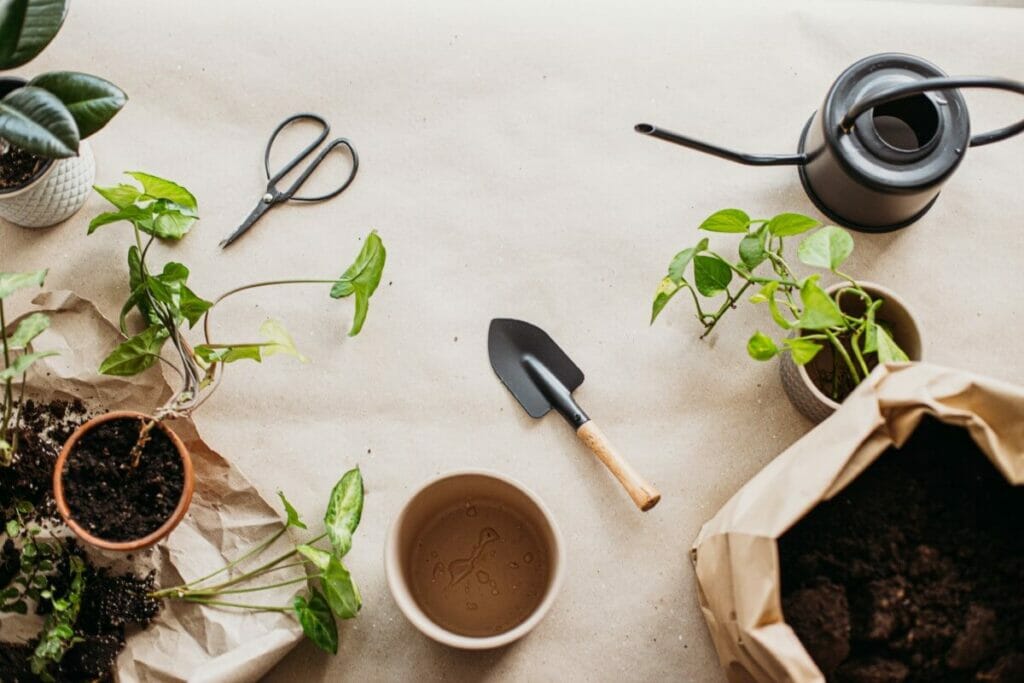
Очистите свои инструменты
Прежде чем приступить к размножению, необходимо убедиться, что все инструменты, с которыми вы будете работать, полностью чисты. Грязные инструменты — рай для бактерий и вредных микробов, которые могут попасть на ваши черенки и препятствовать их росту.
Очистите и продезинфицируйте секаторы или ножницы 5% раствором отбеливателя, если они недавно использовались, или промойте их водой с мылом, если они были ранее продезинфицированы.
Обязательно вымойте любой стакан или горшок, которые собираетесь использовать, прежде всего, если они заранее использовались для других растений.
Удалить стебель
Когда ваши инструменты чистые и готовые, пора выбрать стебель. Ищите здоровый стебель с большим количеством листьев и близко расположенных узлов. Не размножайте поврежденные или больные стебли, так как они просто перейдут на новое растение, что предотвратит рост корней.
Отрежьте кусок выбранного вами стебля длиной не менее четырех дюймов с несколькими наборами листьев. Обрежьте под углом 45 ° сразу под листовым узлом, но не так близко, чтобы вы не повредили узел.
Вы также можете разрезать более длинный стебель на отдельные четырехдюймовые кусочки, чтобы размножить несколько черенков. Обязательно запоминайте направление роста корней, когда делаете срезы, чтобы не сажать черенок в перевернутом виде.
Удалить листву
Удалите листву с нижней половины черенка, следя за тем, чтобы наверху осталось два или три здоровых листа для фотосинтеза.
Любая листва, оставленная в воде или почве, будет гнить и способствовать развитию болезней, поэтому убедитесь, что все листья ниже уровня почвы или воды удалены.
Корни в воде / почве
Соберите черенки и подготовьте их к укоренению в воде или почве.
Чтобы укорениться в воде, оставьте черенки в стакане или специальной станции для выращивания, наполненной фильтрованной или дистиллированной водой. Верхняя половина черенка не должна находиться в воде.
Чтобы укорениться в почве, наполните горшок легкой и воздушной смесью для размножения. Комбинация кокосовой койры, перлита и вермикулита обеспечивает идеальные условия для быстрого роста корней. Как вариант, вы можете купить предварительно приготовленную смесь для размножения.
Посадите нижнюю половину черенков в почву, оставив оставшиеся листья чуть выше уровня почвы. Тщательно полейте после посадки.
После ухода
Растения Pothos, укоренившиеся в воде, нуждаются в постоянном доливе воды. Без дополнительной воды корни начнут задыхаться из-за недостатка кислорода. По мере испарения воды нижняя половина стебля может больше не находиться в воде, что препятствует росту корней.
Добавляйте воду в стакан каждые пару дней и полностью заменяйте воду каждые несколько недель или когда она кажется мутной. Если вы заметили в воде грязь или рост бактерий, очистите стекло и ополосните стебли.
Растения Pothos, укоренившиеся в почве, требуют постоянного полива, чтобы почва оставалась влажной. Убедитесь, что в горшке есть много дренажных отверстий, чтобы стебли не гнили. Держите горшок в месте с ярким непрямым светом для наиболее быстрого и сильного роста корней.
DISPLAY IDEAS
- Pothos can be kept compact and bushy, or allowed to develop a trailing habit. How best to display your pothos depends on how it is trained.
- Grow a trailing plant in a hanging basket and allow the foliage to cascade for an elegant display. Place in a bedroom, living room or office to enjoy the benefits of air purification. (See more indoor hanging plants)
- Train a vining form up a vertical support such as driftwood, bark, a decorative trellis or pole for a natural rain forest effect.
- Allow a vining form to sprawl horizontally along a table top, mantelpiece or bookshelf for a softening, living touch.
- Long runners can be trained along a wall or window frame, the branches secured with small cup hooks. This can give the appearance of integrating the indoors with nature.
- Feature a bushy type in a decorative pot as a living accent on a coffee table, end table, office desk or plant stand. Use a slower growing variegated form to reduce the need for pruning.
- Place a trailing or bushy form on a shelf or hanger in a bathroom where it will thrive on the increased humidity and warmth from showers and baths.
- Display a green or slightly variegated form that needs less light on your office desk to lift your mood during the work day.
- Plant a green variety that tolerates low light in a brightly colored decorative pot. Place in a dull, drab corner of the house to liven up the space.
Propagating in sphagnum moss
You can also propagate scindapsus pictus in moss. There is a less of a shock when transitioning the newly rooted cuttings to soil because the roots are a bit stronger. I like to root them in a mix of sphagnum moss and perlite in my Ikea greenhouse cabinet where the humidity is a bit higher. Just make sure the moss doesn’t dry out. (See my guide all about how to root plants in sphagnum moss.)
Instead of putting a cutting in water, with this method, you put it in a mixture of damp saphgnum moss and perlite. You can put a plastic baggie over the cutting or add it to a Plant Propagation Box, which is easy to make!
For more on scindapsus propagation, see my full Scindapsus Pictus Propagation Guide for detailed instructions and photos!
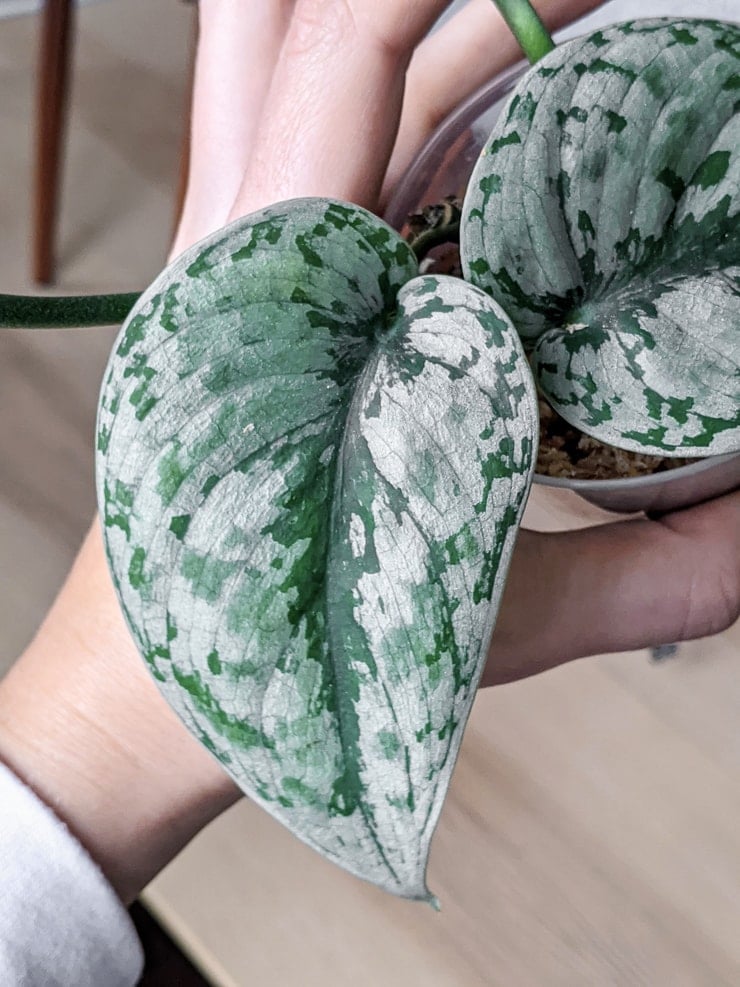
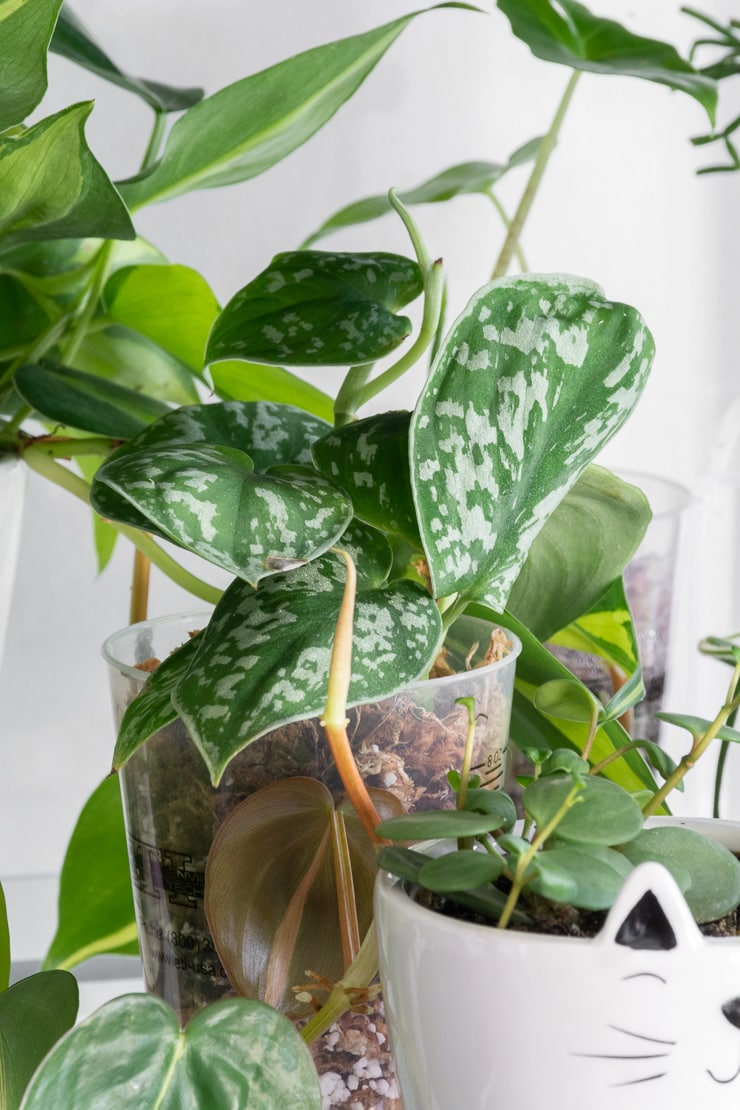
POTHOS BASICS
Light requirements:
Bright indirect light is ideal, but plants are tolerant of low light and fluorescent lighting. Avoid direct sunlight, which can burn or discolor foliage.
Foliage:
Shiny leaves are 4-12 inches long, heart- or lance-shaped, in colors of green, chartreuse, blue, or variegated patterns.
Flowers:
Small, white, hooded flowers are insignificant, occurring on mature plants in their native habitat. Plants will not flower in the average home environment.
Toxicity:
All parts of the plant are mildly to moderately poisonous if ingested by pets or children. See more Common Poisonous Plants for Dogs and Cats.
Pothos lookalikes:
The leaves can look nearly identical to heart-leaf philodendron. Pothos has thicker, more textural leaves, while those of philodendron tend to be darker, smoother, and less likely to be variegated. The leaf stem of pothos has a slight groove, while those of philodendron are smooth. Philodendron foliage is distinctly heart shaped, while pothos leaves can be asymmetrical. They both have similar growing conditions and care requirements.
Pothos is also related to common garden plants such as anthurium, caladium, and calla lily.
How to Grow Devils Ivy Recap
-
Average Light Levels
Pothos is an adaptable houseplant that will do well in light shade or brightly lit spaces. However avoid no light locations as well as direct sunlight. -
Average Watering.
This plant will cope with some dryness at the roots but aim to keep the soil moist. -
Average Temperature.
Provide temperatures between 15°C (59°F) and 25°C (77°F -
Only Occasional Feeding.
Provide feed to the soil once every two months. -
Too much water will cause rot.
Some underwatering can be tolerated. Keeping the soil constantly moist and not letting it dry out a little between waterings and overwatering will cause problems. -
Avoid cold temperatures.
They really aren’t keen on cold temperatures so treat them nicely by keeping your Satin Pothos warm in the winter months.
Сциндапсус перистый (Scindapsus Pinnatum) сорта:
Сциндапсус Моссток (Scindapsus Mosstok = Epipremnum Mosstok)
Редкий вид сциндапсуса с крупными листьями с расцветкой в виде штрихов жёлтого цвета по светло-зелёному фону. Взрослые листья рассекаются на сегменты.
Сциндапсус Моссток (Scindapsus Epipremnum Mosstok)
Интересный и необычный тайский сорт. Небольшие листья насыщенного зелёного цвета по мере взросления видоизменяются до необычной формы, «отращивая» на конце длинный стреловидный отросток.
Сциндапсус Скелетон Ки (Кей) (Scindapsus pinnatum = Epipremnum pinnatum Skeleton key) (Фото — Etsy.com)
Сциндапсус перистый Себу Блю (Scindapsus Cebu Blu = Epipremnum pinnatum Cebu Blue)
Узкие вытянутые листья голубовато-зелёного цвета с металлическим блеском. Взрослые листья при ярком освещении и хорошем уходе естественным образом расщепляются на произвольные сегменты.
Сциндапсус перистый Себу Блю (Scindapsus Cebu Blu = Epipremnum pinnatum Cebu Blue)
Сциндапсус перистый Альба Вариегата (Scindapsus = Epipremnum pinnatum Albo Variegata)
Редкий сорт с крупными, до 40 см, сердцевидными листьями, рассекающимися по мере взросления. Вариегатность чёткая – белые штрихи, полосы, пятна, сегменты по ярко-зелёному фону. Англоязычное название — Вайт Вариегата (White Variegata)
Сциндапсус перистый Альба Вариегата (Scindapsus = Epipremnum pinnatum Albo Variegata)
Сциндапсус уход в домашних условиях
Сциндапсусы разных видов и сортов одинаково неприхотливы и отлично растут при минимальном уходе. Но, чтобы получить красивое и здоровое растение, а также в будущем не иметь лишних хлопот, нужно сразу же обеспечить минимально подходящие условия для цветка.
Во-первых, расположение. Сциндапсусы отлично растут в тени, но большинство декоративных пёстрых сортов проявляют красоту своих листьев при ярком продолжительном освещении. В тени их расцветка стирается и лист становится равномерно зелёным. Особенно это касается вариегатных (пёстрых) сортов сциндапсуса золотистого – голден квин, марбл квин и других. Более устойчив к полутени сциндапсус расписной. Растение следует притенять от прямых солнечных лучей, допустимо только утреннее освещение.
Другим немаловажным фактором при расположении растения – отсутствие сквозняков, резких перепадов температуры и холодных потоков воздуха. В зимнее время всего лишь один сквозняк может стать губительным для растения.
Сциндапсусы теплолюбивы и хорошо растут при средней температуре +20о – 23о. В зимнее время допустимо понижение температуры в среднем до +18о, но не ниже +15о. +12о – критический порог. Летом сциндапсусы хорошо переносят кратковременное повышение до +30о, но при такой погоде требуют дополнительного опрыскивания и более частого полива.
Сциндапсус (Эпипрумнум) популярные сорта: Голден Квин, Марбл Квин, Н-Джой, Неон
Во-вторых – поливы. Как выходцы из влажных тропиков, сциндапсусы требуют регулярных поливов. Сигналом к поливу служит высыхание верхнего слоя почвы на 2-3 см. Летом поливы требуются частые, зимой – реже. Допускать полного пересыхания земляного кома не рекомендуется. Также губителен «залив» растения, застой влаги в горшке, закисание почвы. Это неминуемо приведёт к загниванию корней. Для полива использовать только отстоянную не менее суток воду. Лучше, если вода будет теплее комнатной на 2-5 градусов.
В качестве дополнительного увлажнения можно регулярно опрыскивать растения, хотя среднюю влажность воздуха помещений они переносят нормально. Но при сухом воздухе и зимой опрыскивания обязательны. Летом, в качестве дополнительного ухода, рекомендуется тёплый душ. Если растение стоит у окна, то после душа его рекомендуется полностью высушить перед тем, как ставить на место.
Сциндапсус перистый (Scindapsus pinnatum = Epipremnum pinnatum) Сорта: Себу Блю и Альба Вариегата
Growth rate & repotting
In its natural habitat, scindapsus pictus varieties climb other plants and trees. As a houseplant, it can be trained to climb a pole, or you can grow it in a trailing basket. Its stems can reach over 3 feet long. To encourage more growth, give your plant a well-balanced houseplant fertilizer once a month in the spring and summer.
Speaking from my own experience, this plant is a pretty fast grower. It can start slow, but like all houseplants, it really gets going if it’s happy. Scindapsus pictus can be repotted every 1–2 years to a pot a few inches larger. If you’d like to control the plant’s size, you can take the plant out of its pot, trim the roots, and replant with fresh potting soil. The best time to repot is in the spring or early summer.
Several years ago I acquired a very full scindapsus pictus exotica from a friend who got it at a grocery store. Some of the leaves were also a bit yellow, and I thought it might be rootbound based on the plant’s size.
I actually gasped when I took this guy out of the plastic growers pot. My husband isn’t even into plants and I had to show him. I had to show someone! I hacked at these roots to loosen them up, which broke a decent amount off. That’s okay. The pic below on the right is the plant happily repotted with fresh soil in a hanging basket.
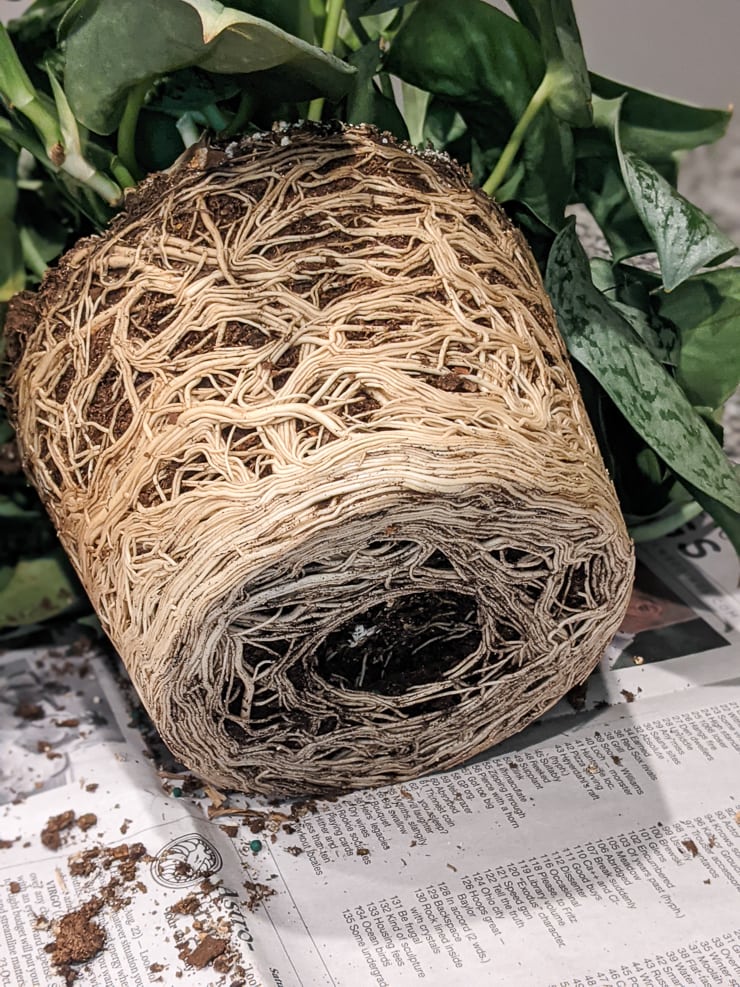
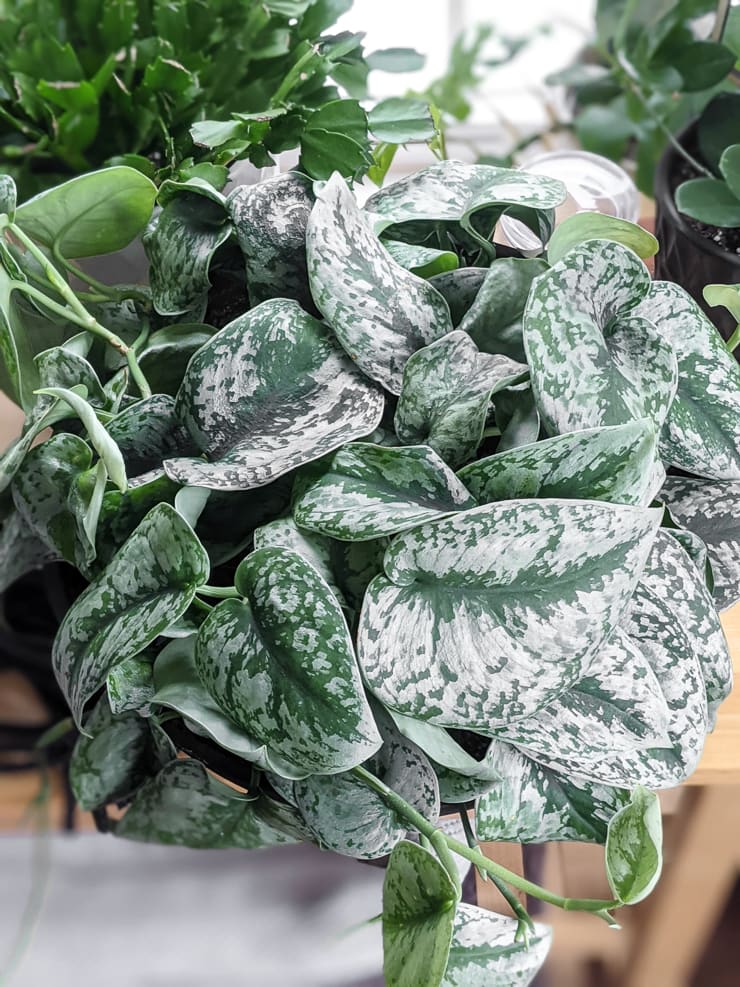
Characteristics And Origin Of Scindapsus Pictus
Satin Pothos is native to the warm and humid regions
of southeastern Asia like Bangladesh, Borneo, the Philippines, Java and Sumatra.
Classified as an evergreen climber, Satin Pothos can grow 10 feet tall when
grown outdoors in frost-free climates, but typically grows around 3 feet tall
when grown indoors either climbing up a moss stick or in hanging baskets.
The juvenile leaves are heart-shaped and as the plant matures, become pinnately lobed. Although when grown indoors the plant rarely flowers, in summer insignificant flower spathes form followed by small berries.
Satin pothos is usually sold as 3 main cultivated varieties;
Scindapsus pictus ‘Argyraeu’ is a hybrid cultivar or variety of the mother plant, with Argyraeu meaning “silvery,” which is because of the silvery markings on the foliage. The foliage edges are lined in silver and with small evenly dispersed silver spots covering the dark green leaves.
Scindapsus pictus ‘Argyraeu’ gained the Royal Horticultural Society’s Award of Garden Merit.
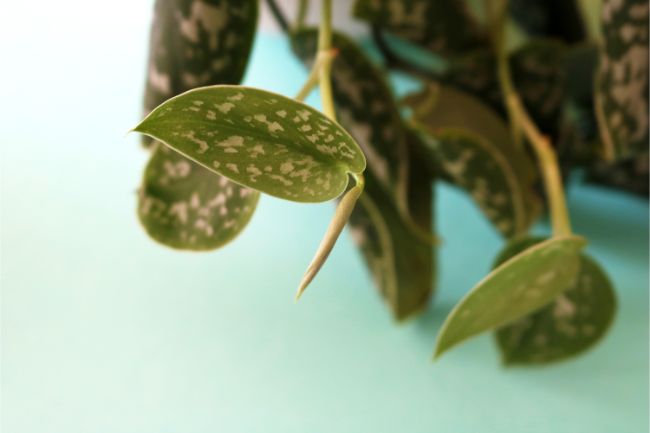
Scindapsus pictus ‘Argyraeu’
Scindapsus pictus ‘Exotica’ has larger, darker green leaves with increased variegation, but less contrast between the green background and the silvery-white leaf markings.
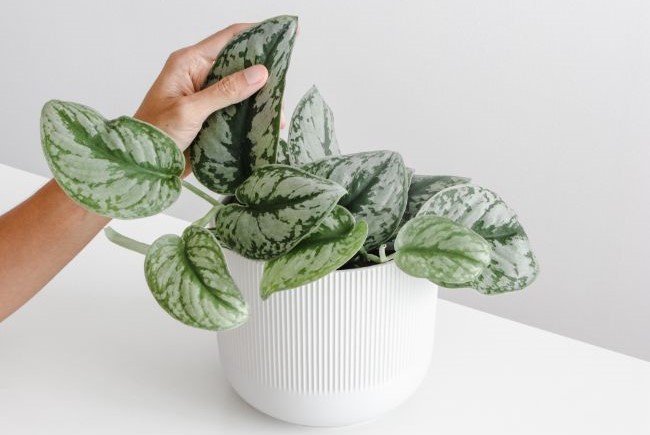
Scindapsus pictus ‘Exotica’
Scindapsus pictus ‘Silvery Anne’ is another hybrid cultivar with even more pronounced variegation, with some leaves almost completely white-silver.
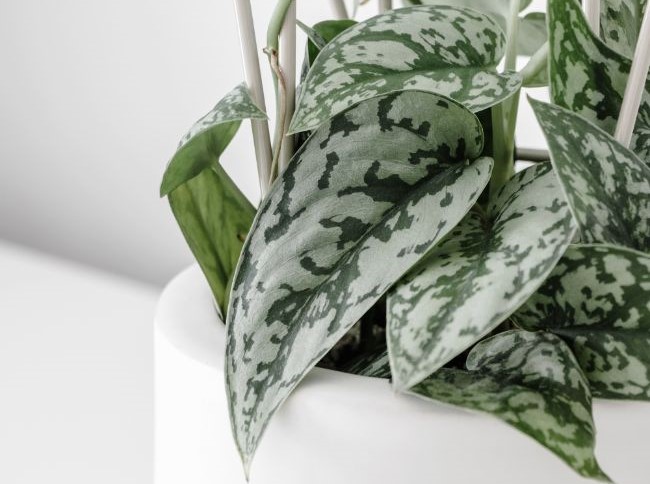
Scindapsus pictus ‘Silvery Anne’






























